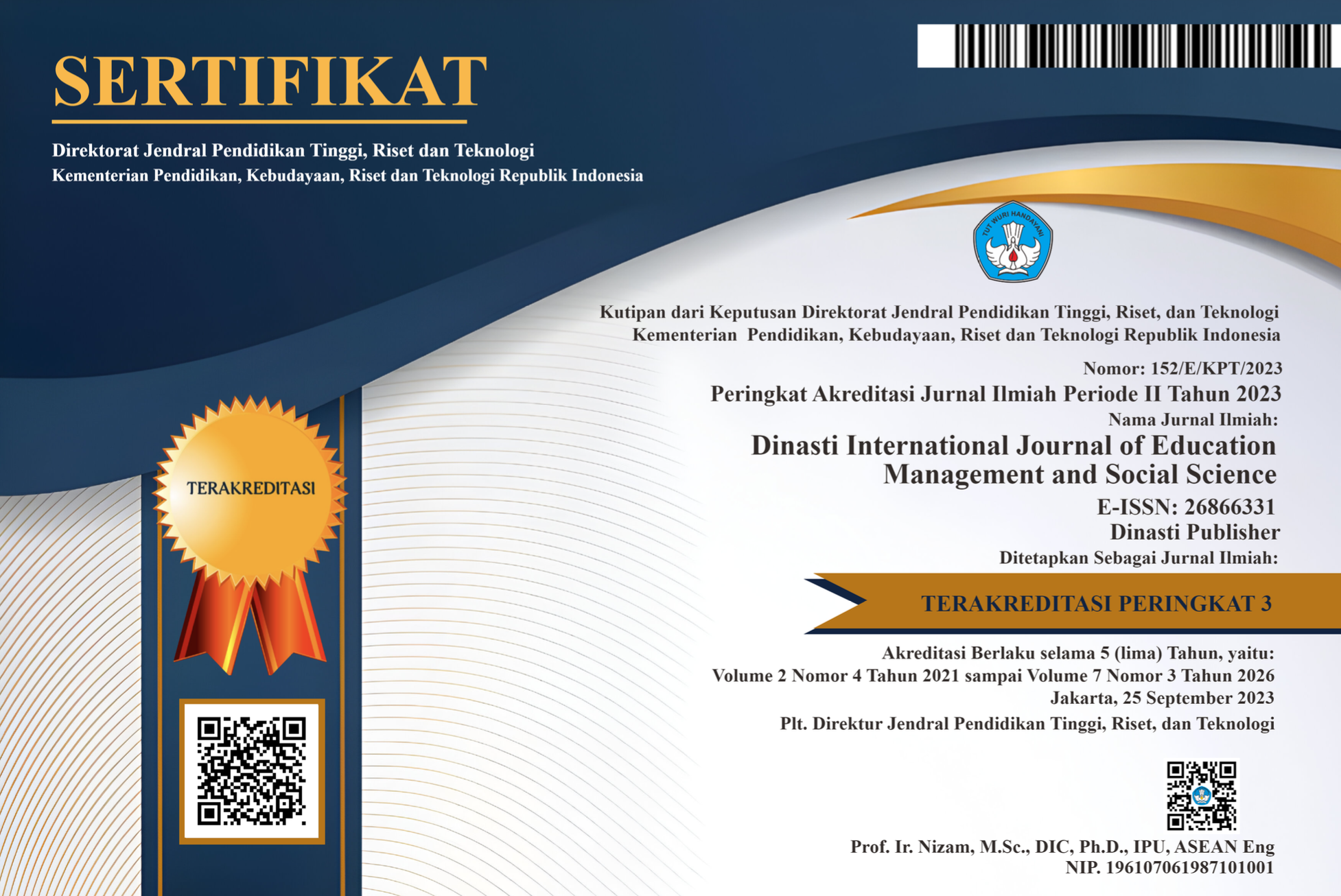Analysis of Entrepreneurial Intentions in the Agricultural Sector (Agri-Preneur) of Agribusiness Students at Universities in Medan City
DOI:
https://doi.org/10.38035/dijemss.v6i5.4728Keywords:
Intention, Entrepreneurship, StudentsAbstract
This study aims to identify students' entrepreneurial intentions at universities in Medan City. This research was conducted due to the issue of unemployment caused by the skill competencies of agribusiness graduates, the generally low interest among students in creating job opportunities, and the declining enthusiasm for entrepreneurship in the agricultural sector. This study employed a survey method with a research population consisting of 920 agribusiness students from the Faculty of Agriculture in Medan City, spread across three universities: UMA, UMSU, and USU. The sample for this study consisted of 90 students from the three universities. The results show that students' entrepreneurial intentions, particularly at universities in Medan City, demonstrate a high level of interest; however, there is a need for accelerated learning and hands-on practice in entrepreneurship. Entrepreneurial intention in Indonesia, especially at universities in Medan City, falls into the high category. The higher the personal values and personalities aligned with entrepreneurship among students, the higher their level of entrepreneurial intention. This indicates that the students' entrepreneurial intentions reflect a positive response toward entrepreneurship.
References
Adebayo, G. S., dan Kavoos, M. (2016). The present attitude of African youth towards entrepreneurship. International Journal of Small Business and Entrepreneurship Research, 4(1), 21-38.
Ajzen, I. (1991). The theory of planned behavior. Organizational behavior and human decision processes, 50(2), 179–211.
Ajzen & Fishbein. (1975). Belief, Attitude, Intention and Behavior: An Introduction to Theory and Research, Addison-Wesley Publishing Company Inc., Menlo Park, California.
Arisandi. (2016). Intensi Berwirausaha Mahasiswa Pascasarjana Institut Pertanian Bogor Pada Bidang Agribisnis (Studi Kasus Pada Mahasiswa Program Magister Sps-IPB). (Pascasarjana). Bogor: Institut Pertanian Bogor.
Arum, R., Muller, W. (2009). The Reemergence of Self-employment: A Comparative Study of Self-employment Dynamics and Social Inequality. Princeton University Press
Arvidsson, V., Monsted, T. (2018). Generating innovation potential: how digital entrepreneurs conceal, sequence, anchor, and propagate new technology. J. Strateg. Inf. Syst, 27(4), 369–383
BPS, B. P. S. (2019). Struktur PDB Menurut Lapangan Usaha 2019. from Badan Pusat Statistika
Devi, M. (2015). Closure and exposure: Mechanisms in the intergenerational transmission of self-employment. Res. Sociol. Org, 25, 83–124.
Sousa, M.J., Carmo, M., Goncalves, C., A., Cruz, C., R., Martins, M., J. (2019). Creating knowledge and entrepreneurial capacity for HE students with digital education methodologies: Differences in the perceptions of students and entrepreneurs. J. Bus. Res, 94, 227– 240.
Sugiyono, P. D. (2015). Data on entrepreneurship education and entrepreneurial performance of aspiring entrepreneurs in selected Nigerian universities. Data Brief, 20, 108–112.
Pindado, E., Sánchez, M., Verstegen, J. A., dan Lans, T. (2018). Center For Rural Entrepreneurship, Understanding the Environment for Entrepreneurship. Retrieved from http://www.entreworks.net/Download/SupportingRuralEntrepreneurship.pdf
Riana, W. C. (2018). Entrepreneurship intention in the agricultural sector of the young generation in Indonesia. Asia pacific journal of innovation and entrepreneurship, 11(1), 76–89.
Rippa, P., Secundo, G. (2019). Entrepreneurship education: the relationship between education and entrepreneurial activity. Psicothema, 23(3), 453–457.
Etzkowitz, H., Germain-Alamartine, E., Keel, J., Kumar, C., Smith, K.N., Albats, E. (2019). Entrepreneurial university dynamics: structured ambivalence, relative deprivation and institution formation in the Stanford innovation system. Technol. Forecast. Soc. Change, 141(C), 159–171.
Fayolle, Alain dan Benoit Gailly. (2015). The Impact of Entrepreneurship Education on Entrepreneurial Attitudes and Intention: Hysteresis and Persistence. Journal of Small Business Management, 53(1), 75- 93.
Henderson, J. (2006). Understanding rural entrepreneurship at the county level: Data challenges. Federal Reserve Bank of Kansas City, Omaha.
Hsieh, Y.J., Wu, Y.J. (2019). Entrepreneurship through the platform strategy in the digital era: insights and research opportunities. Comput. Hum. Behav. 95, 315–323.
Ibrahim, S. B., danAfifi, O. (2018). Determinants of entrepreneurial intentions using the Theory of Planned Behavior. Journal of Economic and Management Sciences, 19(2).
Zampetakis, L. A., Anagnosti, A., dan Rozakis, S. (2013). Intensi Kewirausahaan: Perspektif Karakteristik Kepribadianm, Pembelajaran an Jaringan sosial (studi pada mahasiswa Program Akademik dan Vokasi UM). Jurnal Ekonomi Bisnis, 17(1), 67- 78.
Indarti, N., & Krinstiansen, S. (2003). Determinants of entrepreneurial intention: The case of Norwegian students. Gadjah Mada International Journal of Business, 5(1), 79-95.
Isdianto, B., Willy, D. & Mashudi, M.R. (2005). Orientasi Sistem Pendidikan Desain Interior terhadap Motivasi Kewirausahaan Mahasiswa (Mencari Hambatan dan Stimulus). Laporan Penelitian. Bandung: Institut Teknologi Bandung.
Liana, Y. (2017). Intensi Wirausaha Mahasiswa Untuk Menciptakan Kemandirian Mahasiswa Dalam Berwirausaha. Akutansi Bisnis & Manajemen (ABM), 21(1), 45-56.
Lindquist, M., J., Sol, J., Van Praag, M. (2015). Why do entrepreneurial parents have entrepreneurial children? J. Labor Econ, 33(2), 269-296.
Lynch, M., Kamovich, U., Longva, K. K., Steinert, M. (2019). Combining technology and entrepreneurial education through design thinking: students' reflections on the learning process. Technol. Forecast. Soc. Change. 10.1016/j.techfore.2019.06.015.
Mahmoud, M. A. (2014). Metode penelitian dan pengembangan. Res. Dev. D, 2015, 9–41.
Sumarsono, H. (2016). Need for achievement and entrepreneurial success: a study of entrepreneurs in two rural industries in West Bengal. The Journal of Entrepreneurship 3(2), 191-204.
Shiri, N., Mohammadi, D., dan Hosseini, S. M. (2012). Searching for the entrepreneurs among new entrants in European Agriculture: the role of human and social capital. Land use policy, 77, 19-30.
Raposo, M., Do Paco, A. (2011). Strategi Pembelajaran Berorientasi Standar Proses Pendidikan. Jakarta: Kencana
Prenada Medi Sengupta, S., & S.K. Debnath. (1994). The enterprising farmer: a review of entrepreneurship in agriculture. Royal agricultural society of England journal, 167, 66–75.
Ogbari,M., E., Olokundun, M., A., Uzuegbunam, J., Isiavwe, D., T., Ilogho, J., E., Obi, J., N., Moses, C., L. (2018). The mediating role of self-efficacy in the development of entrepreneurial intentions. Journal of Applied Psychology, 90(6), 1265.
Ljubljana, Slovenia. Zhao, H., Seibert, S. E., & Hills, G. E. (2015). Understanding entrepreneurial intentions of students in agriculture and related sciences. Paper presented at the Poster session presented at the meeting of the EEAE 2014 Congress" Agri-Food and Rural Innovations for Healthier Societies,"
Walyono. (2020). Buku Panduan Kewirausahaan UMA: Entrepeneur Langkah dan Strategi. Medan.
Downloads
Published
How to Cite
Issue
Section
License
Copyright (c) 2025 Muhammad Bobby Ramadhana, Retna Astuti Kuswardani, Emmy Harso Kardhinata, Muhammad Reza Aulia

This work is licensed under a Creative Commons Attribution 4.0 International License.
Authors who publish their manuscripts in this journal agree to the following conditions:
- The copyright on each article belongs to the author(s).
- The author acknowledges that the Dinasti International Journal of Education Management and Social Science (DIJEMSS) has the right to be the first to publish with a Creative Commons Attribution 4.0 International license (Attribution 4.0 International (CC BY 4.0).
- Authors can submit articles separately, arrange for the non-exclusive distribution of manuscripts that have been published in this journal into other versions (e.g., sent to the author's institutional repository, publication into books, etc.), by acknowledging that the manuscript has been published for the first time in the Dinasti International Journal of Education Management and Social Science (DIJEMSS).















































